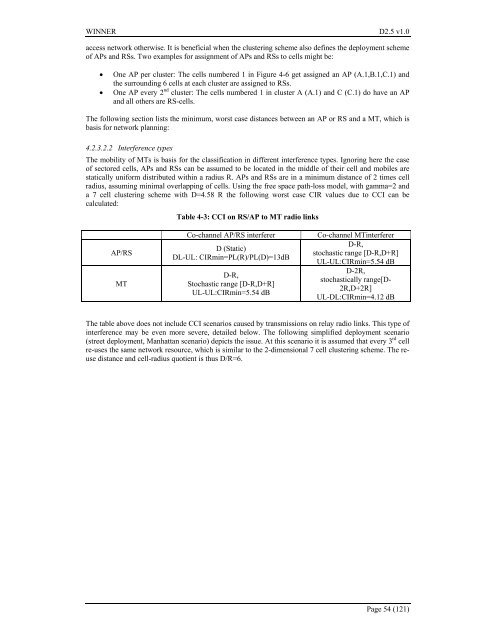IST-2003-507581 WINNER D2.5 v1.0 Duplex ... - Celtic-Plus
IST-2003-507581 WINNER D2.5 v1.0 Duplex ... - Celtic-Plus
IST-2003-507581 WINNER D2.5 v1.0 Duplex ... - Celtic-Plus
- No tags were found...
Create successful ePaper yourself
Turn your PDF publications into a flip-book with our unique Google optimized e-Paper software.
<strong>WINNER</strong> <strong>D2.5</strong> <strong>v1.0</strong>access network otherwise. It is beneficial when the clustering scheme also defines the deployment schemeof APs and RSs. Two examples for assignment of APs and RSs to cells might be:• One AP per cluster: The cells numbered 1 in Figure 4-6 get assigned an AP (A.1,B.1,C.1) andthe surrounding 6 cells at each cluster are assigned to RSs.• One AP every 2 nd cluster: The cells numbered 1 in cluster A (A.1) and C (C.1) do have an APand all others are RS-cells.The following section lists the minimum, worst case distances between an AP or RS and a MT, which isbasis for network planning:4.2.3.2.2 Interference typesThe mobility of MTs is basis for the classification in different interference types. Ignoring here the caseof sectored cells, APs and RSs can be assumed to be located in the middle of their cell and mobiles arestatically uniform distributed within a radius R. APs and RSs are in a minimum distance of 2 times cellradius, assuming minimal overlapping of cells. Using the free space path-loss model, with gamma=2 anda 7 cell clustering scheme with D=4.58 R the following worst case CIR values due to CCI can becalculated:Table 4-3: CCI on RS/AP to MT radio linksAP/RSMTCo-channel AP/RS interfererD (Static)DL-UL: CIRmin=PL(R)/PL(D)=13dBD-R,Stochastic range [D-R,D+R]UL-UL:CIRmin=5.54 dBCo-channel MTinterfererD-R,stochastic range [D-R,D+R]UL-UL:CIRmin=5.54 dBD-2R,stochastically range[D-2R,D+2R]UL-DL:CIRmin=4.12 dBThe table above does not include CCI scenarios caused by transmissions on relay radio links. This type ofinterference may be even more severe, detailed below. The following simplified deployment scenario(street deployment, Manhattan scenario) depicts the issue. At this scenario it is assumed that every 3 rd cellre-uses the same network resource, which is similar to the 2-dimensional 7 cell clustering scheme. The reusedistance and cell-radius quotient is thus D/R=6.Page 54 (121)
















